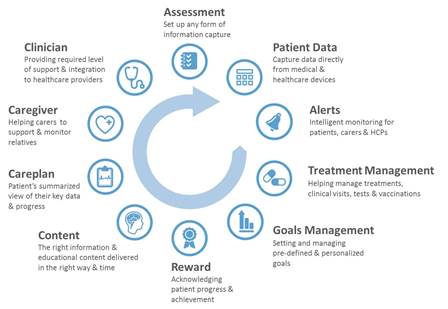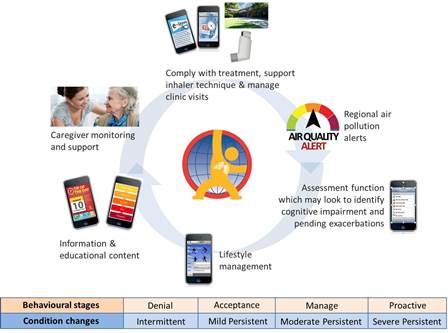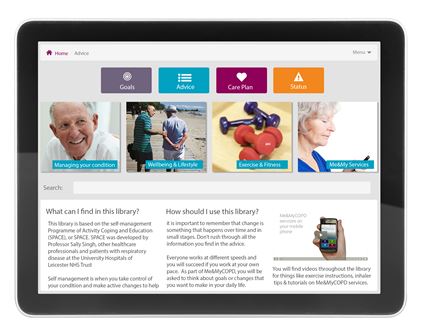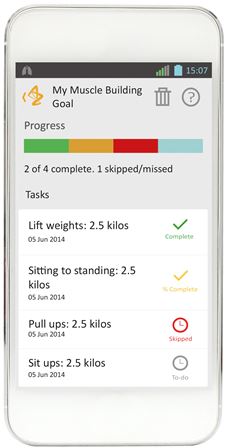Going beyond the pill — mhealth programme improves outcomes for COPD patients
Mark Brincat, Director of Product Strategy, Exco InTouch
11 August 2014
mHealth offers pharmaceutical companies the opportunity to go ‘beyond the pill’ and deliver personalised health support to patients outside of a healthcare setting. Digital health platforms can keep patients involved in managing their care and adherent to their therapy and medication regimes.
These mHealth solutions not only benefit the patients and improve their quality of life; improved health outcomes also provide clear return on investment for health payers and address the rising costs of healthcare.
Facing the chronic disease crisis
The rise in the number of patients suffering from chronic conditions worldwide, and the associated treatment costs are putting increasing pressure on healthcare systems around the world. To take diabetes as an example, in America alone only 18 million out of the estimated 24 million sufferers are diagnosed, while as little as 15 million of them get treated. Of that number, only 6 million patients are well controlled [1].
Similarly, treating diabetes in the UK consumes around 15% of the national healthcare budget. However, as much as 80% of this is spent dealing with the downstream consequences of poor control [2]. According to the WHO Report (2003), eliminating under-diagnosis and under-treatment of patients suffering from chronic conditions and improving the effectiveness of adherence interventions could not only have a greater impact on the health of the population than any improvement in specific medical treatments, it could also almost double savings in medical care expenses [3].
It is estimated that increased adherence could decrease care costs of the US diabetes patients from as much as $8,867 to $4,570 per year, resulting in $4,297 savings [4].
It is the widespread recognition of these pressures and the advent of mHealth technologies that has offered pharmaceutical companies the opportunity to go ‘beyond the pill’ and deliver better care or patients and better solutions for care providers.
The importance of going ‘beyond the pill’
Advances in mobile technology and the rise of mHealth have an enormous potential to make a real difference in healthcare, not just for individuals, but of whole nations. AstraZeneca are leading the way through designing mHealth programmes to address the inability to manage treatment for individual patients suffering from chronic conditions, their caregivers, and their healthcare providers (HCPs) through their Intelligent Pharmaceuticals initiative. In 2013 AstraZeneca announced their collaboration with Exco InTouch to develop a ground-breaking programme using interactive mobile phone and internet-based health tools to help patients, caregivers and their healthcare providers track and manage chronic conditions.
The main benefits of leveraging digital technology to support patients come from remote monitoring, long term control, proactive condition management and data collection. The initial focus for this collaboration has been on patients suffering from chronic obstructive pulmonary disease (COPD), through the AstraZeneca’s Me&MyCOPD programme. The programme is set to give the enrolled patients the opportunity to access personalised coaching and real-time information about their disease and treatment via their mobile phones or other web enabled devices, and to use digital technology to securely collect, transmit and review their own clinical data.
As a result the programme ultimately leads to patients being able to better control their conditions and HCPs able to make more informed decisions and tailor care pathways to personalise each patient’s disease management, optimising health outcomes. This translates into improving patient welfare and quality of life by reducing the number of unplanned hospital admissions and the frequency and severity of exacerbations, decreasing the overall cost of treatment at the same time.
Building scalable solutions
One of the most important considerations when designing truly engaging mHealth services is to tailor each programme to the primary issues and challenges facing that patient population. Figure 1 illustrates a typical range of patient and health provider components from the Exco InTouch platform, which can be utilised in order to create a seamless multi-level programme. Each programme is uniquely adapted to each patient population, integrating effectively into defined care pathways and providing a personalised level of support. Figure 2 shows how the modules could be adapted for a COPD patient population.

Figure 1. mHealth Interventions Wheel developed by Exco InTouch
Case study: The AstraZeneca’s Me&MyCOPD programme
The Me&MyCOPD programme has been developed using the modular approach shown in Figure 1. The treatment module is especially relevant in COPD management as improper use of medications is a common problem among COPD sufferers. For this reason AstraZeneca has incorporated tracking of medication use and addresses any issues through patient training, managing their clinic visits, supporting pulmonary rehabilitation and providing the patients with advice on how to manage their lifestyle to limit the negative outcomes of their condition.
Assessment is another important element, therefore the programme
captures a broad range of patient information; whether it’s
understanding patients’ needs and preferences, identifying changes
in their condition or providing personal goals management tools.
This element is supported by providing information and educational
content to patients, mapping it into the system through a care
module.
In addition, the modular platform developed by Exco
InTouch feeds through a rules engine and is fully adaptable
according to specific requirements and amendable to consider
different stages of patient journey.

Figure 2. Example platform adapted for the needs of COPD Patients
Furthermore, this modular approach proves sustainable for mHealth providers in that different interventions and functionality can be added over time, creating new products that can be used in markets with different clinical pathways.
There are three principle parts of the Me&MyCOPD system: a portal, through which different stakeholders can be engaged to work with the patients (Figure 3); a mobile element, which works with the patients in real time and responds to their immediate needs; and the server, where information is processed offline and messages are scheduled. All three parts of the system work together on multiple levels to deliver personalised support to patients’ real needs.

Figure 3. The patient portal
Patients suitable for the programme are identified by trained HCPs and enrolled to individualised self-management plans, which can be tailored towards individual needs and goals according to each patient’s disease progression (Figure 4). The programme uses clinically validated assessments to support patients to reduce the probability of exacerbations occurring, and ultimately to reduce hospitalisations.

Figure 4. A self-management plan can be
designed in a smartphone app, here showing personalised goals for
weight loss
Real-time access to patient data
Information provided to the programme’s participants can be accessed in a variety of ways, whether through internet portals or mobile devices. Real-time access to patients’ data not only guarantees the ability to monitor their adherence to treatment regimes, but also to identify the sudden deterioration of their conditions. This allows for a timely intervention when necessary and referral to HCP for further support and assistance.
If their condition continues to worsen, the patients could be signposted to see their HCP based on the outcome of their assessment. The breakdown of events is not only shared with the patients, their HCP(s) can also be provided information on when the exacerbation took place, the form of intervention, how the patients reacted and how they moved through to becoming well again.
The overall outcomes of the programme are measured through questionnaires and assessments on the use of rescue medications and adherence to standard medications by participants, as well as through an assessment of the impact on the patients’ management of their condition. In addition, payers can monitor the impact on exacerbations and hospital admissions for these patients.
Tomorrow’s approach - today
The Me&MyCOPD programme rolled out by AstraZeneca and Exco InTouch not only improves the long-term engagement and the pro-active management of COPD among individual patients, it provides a comprehensive system to all of the stakeholders within the healthcare system, including caregivers, HCPs and healthcare payers. The programme is the first to employ a personalised, truly mobile approach to monitor, support and empower patients to take control of their condition, utilising their own communication devices.
Moreover, the programme ultimately allows AstraZeneca to focus their efforts to deliver new medicines that will address unmet needs by expanding their understanding of how patients use and respond to various treatment options. This underpins the ‘Intelligent Pharmaceuticals’ strategy adopted by AstraZeneca and is a leading example of how optimised treatment can improve patients’ quality of life and health outcomes.
References
1. PhRMA (2014) from NHANES CDC. Downloaded from:
www.phrma.org/diabetes-example-underdiagnosis
-undertreatment (as of 07/03/2014
).
2. World Health Organization (2010). Global status report on noncommunicable diseases. Downloaded from
http://www.who.int/nmh/publications/ncd_report_full_en.pdf (as of 07/03/2014).
3. World Health Organization (2003). Adherence to Long-Term
Therapies. Evidence for action. Downloaded from
www.who.int/chp/knowledge/publications/,
adherence_introduction.pdf (as of 07/03/2014).
4. Sokol M, McGuigan K, Verbrugge R, Epstein R (2005). Medical Care, Vol. 43, No. 6, pp.: 521-530.